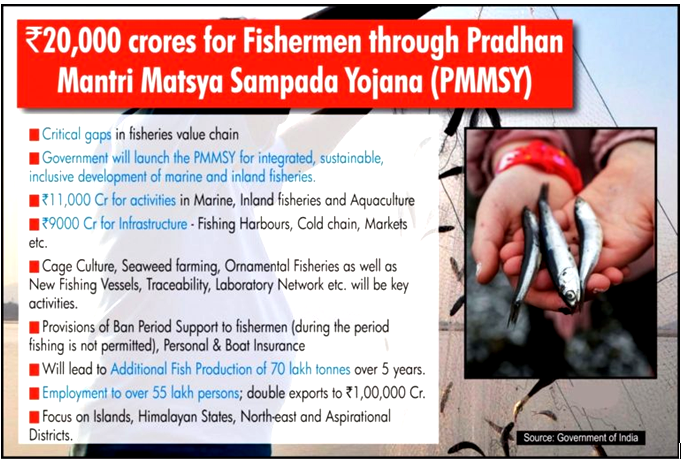Pradhan Mantri Matsya Sampada Yojana
- 23 May 2020
- On 20th May, 2020, the Union Cabinet approved the Pradhan Mantri Matsya Sampada Yojana (PMMSY) - a scheme to bring about Blue Revolution through sustainable and responsible development of fisheries sector in India.
- The PMMSY was announced recently in the third tranche of the Rs 20.97 lakh crore Atmanirbhar Bharat package by the government.
- However, PMMSY first figured during the 2019-20 Budget, presented on July 5, 2019.
Need
- The fish production in India during 2017-18 was estimated to be 12.60 million metric tonnes, of which nearly 65% came from the inland sector while about 50% of the total production was from culture fisheries.
- Therefore, India’s contribution was 6.3 per of the global fish production in the year 2017-18.
- India exports more than 50 different kinds of fish and shellfish products to about 75 countries worldwide.
Aims and Objectives
- Harnessing of fisheries potential in a sustainable, responsible, inclusive and equitable manner
- Enhancing of fish production and productivity through expansion, intensification, diversification and productive utilization of land and water
- Modernizing and strengthening of value chain - post-harvest management and quality improvement
- Doubling fishers and fish farmers incomes and generation of employment
- Enhancing contribution to Agriculture GVA and exports
- Robust fisheries management and regulatory framework
Salient Features of PMMSY
Time Period
- PMMSY will be implemented over a period of 5 years from FY 2020-21 to FY 2024-25 in all States/Union Territories.
Components
- It will be implemented as an umbrella scheme with two separate Components namely (a) Central Sector Scheme (CS) and (b) Centrally Sponsored Scheme (CSS).
Central Sector Scheme (CS)
- The entire project cost will be borne by the Central government (i.e. 100% central funding).
Central Sector Scheme Component (CSS)
- The funding pattern for the Northeastern and Himalayan states will be 90% central share and 10% state share
- For other states it will be 60% central share and 40% state share
- For Union territories (with and without legislature) it will be 100% central share.
This component is segregated into Non-beneficiary oriented and Beneficiary orientated sub-components/activities under the following three broad heads:
- Enhancement of Production and Productivity
- Infrastructure and Post-harvest Management
- Fisheries Management and Regulatory Framework
State Programme Units
- A well-structured implementation framework would be established for effective planning and implementation of PMMSY.
- This inter-alia includes creation of State Programme Units in all States/UTs & District Programme Units and Sub-District Programme Unit in high fisheries potential districts.
Cluster or Area-Based Approach
- For optimal outcomes, ‘Cluster or area-based approach’ would be followed with requisite forward and backward linkages and end to end solutions.
- Suitable linkages and convergence will be fostered with other centre and state government schemes wherever feasible.
Thrust to New Technologies
- Thrust will be given for infusing new and emerging technologies like Re-circulatory Aquaculture Systems, Biofloc, Aquaponics, Cage Cultivation to enhance production and productivity, quality, productive utilization of waste lands and water for Aquaculture.
Special Focus
- Special focus on Coldwater fisheries development and expansion of Aquaculture in Brackish Water and Saline Areas.
- Focused attention would be given for fisheries development in Jammu and Kashmir, Ladakh, Islands, Northeast, and Aspirational Districts through area specific development plans.
Holistic Development
- It envisages development of Coastal fisher communities in a holistic manner through integrated modern coastal fishing villages with necessary infrastructure.
- Collectivization of fishers and fish farmers through Fish Farmer Producer Organizations (FFPOs) to increase bargaining power of fishers and fish farmers is a key feature of PMMSY.
- Well-structured extension support services are envisaged under PMMSY.
- Besides, large number of Fisheries Extension Services Centers would be set up in private space to create job opportunities to young professionals.

Major Impact
- Addressing the critical gaps in the fisheries sector and realize its potential.
- Augmenting fish production and productivity at a sustained average annual growth rate of about 9% to achieve a target of 22 million metric tons by 2024-25 through sustainable and responsible fishing practices.
- Improving availability of certified quality fish seed and feed, traceability in fish and including effective aquatic health management.
- Creation of critical infrastructure including modernisation and strengthening of value chain.
- Creation of direct gainful employment opportunities to about 15 lakh fishers, fish farmers, fish workers, fish vendors and other rural/urban populations in fishing and allied activities and about thrice this number as indirect employment opportunities including enhancement of their incomes.
- Boost to investments in fisheries sector and increase of competitiveness of fish and fisheries products.
- Social, physical and economic security for fishers and fish workers.
- Reduction of post-harvest losses from the reported 20-25% to about 10%.
- Enhancement of the domestic fish consumption from about 5-6 kg to about 12 kg per capita.
Way Forward
- Fisheries and aquaculture are an important source of food, nutrition, employment and income in India.
- The Gross Value Added (GVA) of fisheries sector in the national economy during 2018-19 stood at Rs 2,12,915 crores (current basic prices) which constituted 1.24% of the total National GVA and 7.28% share of Agricultural GVA. T
- The sector has immense potential to double the fishers and fish farmers’ incomes as envisioned by government and usher in economic prosperity.
- The scheme intends to address issues like low productivity in inland Aquaculture, disease, sustainability of marine fisheries, sanitary and phyto-sanitary matters that impact the competitiveness of India’s exports along with global bench marking.

